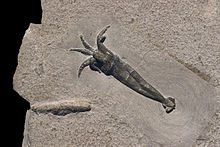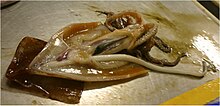Overview
Introduction
Nervous System
Reproductive System
Digestive System
Modification from ancestral forms
The ancestral shell has been lost, with only an internal gladius, or pen, remaining. The pen is a feather-shaped internal structure that supports the squid's mantle and serves as a site for muscle attachment. It is made of a chitin-like material.
Introduction
The skin is covered in chromatophores, which enable the squid to change color to suit its surroundings, making it practically invisible. The underside is also almost always lighter than the topside, to provide camouflage from both prey and predator.
Under the body are openings to the mantle cavity, which contains the gills (ctenidia) and openings to the excretory and reproductive systems. At the front of the mantle cavity lies the siphon, which the squid uses for locomotion via precise jet propulsion.[3] In this form of locomotion, water is sucked into the mantle cavity and expelled out of the siphon in a fast, strong jet. The direction of the siphon can be changed, to suit the direction of travel.
Inside the mantle cavity, beyond the siphon, lies the visceral mass, which is covered by a thin, membranous epidermis. Under this are all the major internal organs.
Nervous system
The giant axon, which may be up to 1 mm (0.04 in) in diameter in some larger species, innervates the mantle and controls part of the jet propulsion system.As cephalopods, squid exhibit relatively high intelligence among invertebrates. For example, groups of Humboldt squid hunt cooperatively, using active communication. (See Cephalopod intelligence.)
Reproductive system
A dissected male specimen of Onykia ingens, showing a non-erect penis (the white tubular structure located below most of the other organs)
Males do not possess these organs, but instead have a large testis in place of the ovary, and a spermatophoric gland and sac. In mature males, this sac may contain spermatophores, which are placed inside the female's mantle during mating.
Shallow water species of the continental shelf and epipelagic/mesopelagic zones are characterised by the presence of hectocotyli, specially modified arms used to fertilise the female's eggs.[4] Most deep sea squid lack hectocotyli and have longer penises; Ancistrocheiridae and Cranchiinae are exceptions.[4] Giant squid of the genus Architeuthis are unusual in that they possess both a large penis and modified arm tips, although it is uncertain whether the latter are used for spermatophore transfer.[4] Penis elongation has been observed in the deep water species Onykia ingens; when erect, the penis may be as long as the mantle, head and arms combined.[4][5] As such, deep water squid have the greatest known penis length relative to body size of all mobile animals, second in the entire animal kingdom only to certain sessile barnacles.[4]






Tidak ada komentar:
Posting Komentar